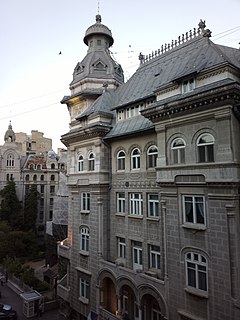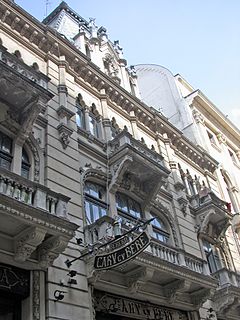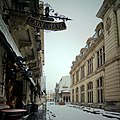The Palace of the Parliament, also known as the Republic's House or People's House/People's Palace, is the seat of the Parliament of Romania, located atop Dealul Spirii in Bucharest, the national capital. The Palace reaches a height of 84 metres (276 ft), has a floor area of 365,000 square metres (3,930,000 sq ft) and a volume of 2,550,000 cubic metres (90,000,000 cu ft). The Palace of the Parliament is the heaviest building in the world, weighing about 4,098,500,000 kilograms, also being the second largest administrative building in the world.

The unification of Moldova and Romania is a popular concept in the two countries that began in the late 1980s, during the Revolutions of 1989. The Romanian Revolution in 1989 and the independence of Moldova in 1991 further contributed to the development of a movement for the unification of the two Romanian-speaking countries. The question of reunification is recurrent in the public sphere of the two countries, often as a speculation, both as a goal and a danger. Though historically Romanian support for unification was high, a 2022 survey during the Russo-Ukrainian War indicated that only 11% of Romania's population supports an immediate union, while over 42% think it is not the moment.

Hanul cu Tei is one of the few still standing old inns in central Bucharest, Romania.

A statue of Ion Luca Caragiale, sculpted by Constantin Baraschi, is located on Maria Rosetti Street in central Bucharest, Romania. It is placed in front of the house where the dramatist and short story writer Ion Luca Caragiale once lived.
Dimitrie Cantemir Christian University is a private university in Bucharest. The university was founded in 1990 by Momcilo Luburici and Corina-Adriana Dumitrescu as the Dimitrie Cantemir Independent University, which has since developed 17 faculties in Bucharest, Brașov, Cluj-Napoca, Constanța and Timișoara.

The Spiru Haret University is a private university in Bucharest, Romania, founded in 1991 by the president of Tomorrow's Romania Foundation, Aurelian Gh. Bondrea, as part of the teaching activities of this foundation. The university claims this has been done according to the model used by Harvard University. The university bears the name of a scientist and reformer of the Romanian education, Spiru Haret, who lived before World War I.
The following lists events that happened during 2013 in Romania.

Sebastian Papaiani was a Romanian film and television actor.

Știința Stadium is a football stadium in Timișoara. Opened in 1928, the stadium is located on the campus of the Polytechnic University of Timișoara. The stadium has an athletics track, an electronic scoreboard, floodlights, as well as facilities for athletes. Politehnica Timișoara, the city's flagship team, played on this stadium until the construction of Dan Păltinișanu Stadium. It is now used by Liga II team SSU Politehnica Timișoara.
The third season of the Romanian reality talent show Vocea României premiered on ProTV on September 28, 2013. Pavel Bartoș and Nicoleta Luciu returned as hosts, with Vlad Roșca as the social media correspondent. All four coaches returned for their third season. The show was moved from its usual Tuesday evening slot to Saturday evening.

Caru' cu Bere is a bar and restaurant on Stavropoleos Street in the Lipscani district of Bucharest, Romania. The business was originally opened as a brewery in 1879 by Ioan Căbășan and his nephews, Ion, Gheorghe, and Nicolae Mircea. They were originally citizens of the Austro-Hungarian Empire and from Cața, Transylvania. In 1889, Căbășan assigned his lease to his eldest nephew, Ion. Ion died later that same year and was replaced in the family firm by the youngest sibling, Víctor.

The 2012–2015 unrest in Romania refers to a prolonged period of civil unrest and political scandals in Romania, which took magnitude after the second half of the 2000s. The wave of civil demonstrations started in January 2012, once with the introduction of a new health reform legislation. The protests were fueled by the austerity measures applied in May 2010, but also by the unpopularity of Băsescu-backed Boc government. The demonstrations were characterized by widespread rioting and acts of vandalism. The political situation precipitated, so Prime Minister Emil Boc decided to step down on 6 February 2012.
The following lists events that happened during 2015 in Romania.

The Colectiv nightclub fire was a deadly fire in Bucharest, Romania, on 30 October 2015, which killed 64 people and injured 146. The fire, which was the deadliest fire in the country's history, occurred during a free concert performed by the metalcore band Goodbye to Gravity to celebrate the release of their new album, Mantras of War. The band's pyrotechnics, consisting of sparkler firework candles, ignited the club's flammable polyurethane acoustic foam, and the fire spread rapidly. Most of the victims were poisoned by toxins released from the burning foam. Overwhelmed by the high number of victims, Romanian authorities transferred some of the seriously injured to hospitals in Israel, the Netherlands, Belgium, Austria, the United Kingdom, Norway, Germany and France. Mass protests over the corruption linked to the fire led to the resignation of the Prime Minister of Romania, Victor Ponta.

The 2015 Romanian protests began on 3 November, when more than 15,000 people protested in front of Victoria Palace—the headquarters of the Romanian government—blocking traffic in Victory Square.

Globalworth Tower, known previously as Bucharest One, is a class A office building that is located in the northern part of Bucharest, Romania, in the vicinity of Calea Floreasca, Barbu Văcărescu Boulevard and Pipera. The building has a total of 26 floors and a gross leasable area of 54,700 m2 (589,000 sq ft). The 118 m (387 ft) high building is the second tallest in Bucharest and Romania just under the 137 m (449 ft) Floreasca City Center's Sky Tower. The construction of the building started in 2014 and was completed in 2015 at a total cost of €60 million.

The Save Romania Union is a liberal and neoliberal political party in Romania, currently the third largest party in the Parliament with 46 deputies and 23 senators, and fifth at national level, after the Democratic Alliance of Hungarians in Romania (UDMR/RMDSZ) and the People's Movement Party (PMP), two other centre-right political parties in the country.

The COVID-19 pandemic in Romania is part of the ongoing pandemic of coronavirus disease 2019 caused by severe acute respiratory syndrome coronavirus 2. The virus was confirmed to have reached Romania on 26 February 2020, when the first case in Gorj County was confirmed.
COVID-19 vaccination in Romania started on 27 December 2020. It was announced that the process would be divided into three phases. Medical personnel would be vaccinated first, followed by the population at risk, and finally by the rest of the population. Vaccination was declared free and non-mandatory. As of March 2022, five types of vaccines were authorized to be used in Romania. This is the largest vaccination campaign in the modern history of Romania.
During the COVID-19 pandemic, Romania has supported Moldova on several occasions, supplying it with medical equipment and supplies, volunteer Romanian experts and doctors and even a series of COVID-19 vaccine units that arrived on 27 February 2021, which allowed Moldova to start its vaccination program.




















